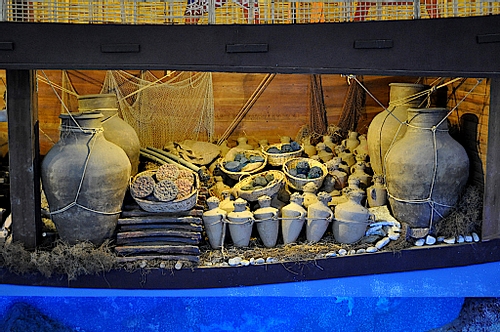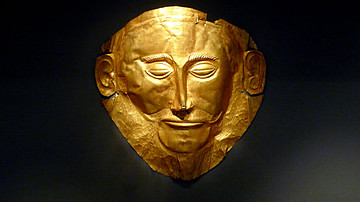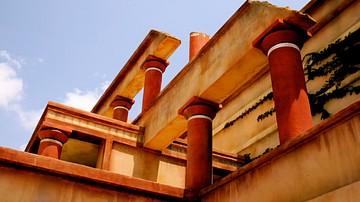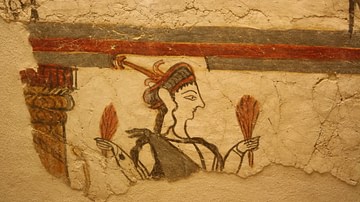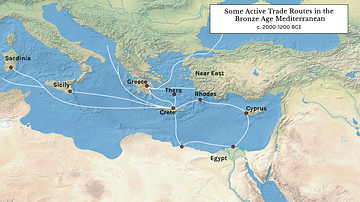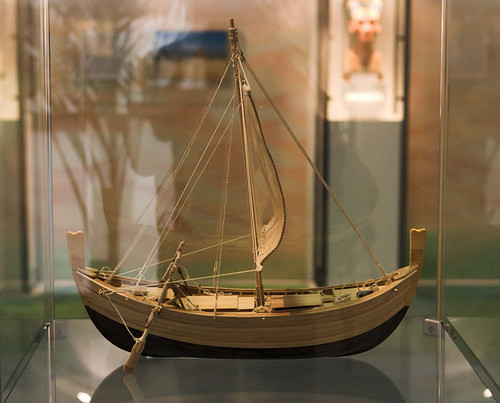
The Uluburun Shipwreck is a Bronze Age vessel discovered lying off the coast of Kas, Turkey. The ship, probably originally from Phoenicia/Canaan, dates to between 1330 and 1300 BCE and was carrying a full cargo of trade goods, perhaps from a port in the southern part of ancient Lycia and likely on its way to the Greek mainland. Marine archaeologists excavated the site over eleven seasons beginning in 1984 CE and have accumulated over 17 tons of artefacts - a treasure trove of goods and information on the trade and cultural interaction across the ancient Bronze Age Mediterranean.
Dating
Radiocarbon dating techniques and the presence of identifiable pottery types place the date of the wreck as sometime in the late 14th century BCE, probably between 1330 and 1300 BCE. Unfortunately, much of the actual ship has not survived, but portions of the keel and planking and the total quantity of goods found in it have helped create a reconstruction of the ship's size. It is estimated the Uluburun wreck was once around 15 metres in length, 5 metres wide and capable of carrying up to 20 tons of cargo. The hull and keel were made from Lebanese cedar with fixtures and fastenings in oak.
Cargo
Thanks to the depth of the wreck (44-61 metres), it had not been plundered prior to its archaeological excavation by the Institute of Nautical Archaeology of Texas A&M University. A consequence of this depth, though, was that divers were limited in the time they could spend on the wreck, resulting in over 22,400 dives to bring up over 17 tons of artefacts. An additional difficulty was the disintegration of the wreck over a steep slope which spread the cargo over some 250 square metres.
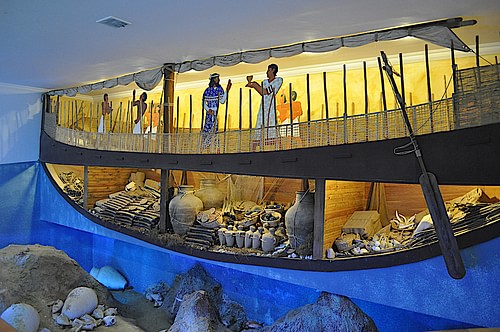
The main cargo of the ship was raw materials. The largest item was copper ingots, 348 of them, totalling 10 tons in weight. These took the form of 'oxhide' and circular buns, which refers to the shape they had, forms common in the Bronze Age Mediterranean. Lead isotope analysis revealed the ingots were pure copper and from Cyprus. The ingots were placed in four rows along the length of the ship's hold in a herringbone arrangement to minimise their movement while at sea.
The next biggest load was 120 pure tin ingots (also in 'oxhide' or bun shape) weighing over a ton in total. Analysis showed that these ingots were originally from mines in the Taurus mountains in Turkey and a source in Afghanistan or nearby; although the fact many of them were cut into four pieces suggests they were not taken directly from the mines but had already been traded elsewhere. There were around 150 Canaanite jars of terebinth resin, the largest such find ever. Analysis of pollen within the resin indicates it came from Israel.
In nine Cypriot pithoi (large storage jars) there were carefully stored Cypriot pottery wares, olive oil or pomegranates. There was a quantity of glass disk ingots, perhaps over 175, weighing a total of 350 kilos but most were eroded. The glass was in four colours: dark blue, turquoise, purple, and yellow, no doubt, destined to be cut into beads or used as inlay in jewellery as a cheaper imitation of the more precious materials lapis lazuli, turquoise, amethyst, and amber respectively. There were also some 70,000 beads on board in glass and faience. Finally, regarding heavy materials, there was around one ton of cobble ballast in the ship.
Miscellaneous goods on the ship, of which there were many, include 24 ebony logs, ivory in the form of a single elephant tusk and 14 hippopotamus teeth, and manufactured ivory goods. There are many pieces of jewellery made from gold, silver, bronze, tin, faience, and glass. In the same materials, there are also figurines, vessels, and weapons. Wooden items have not survived well but there are remains of high-quality boxes. More exotic items on board include Baltic amber, an Italian sword, three ostrich eggshell vases, and cylinder seals from Mesopotamia. Perishable goods, besides those already mentioned, known to have been carried on the ship included spices (cumin, sumac), herbs (coriander, sage), condiments (safflower), olives, almonds, grapes, figs, grain, murex shells, and orpiment, a yellow mineral used as a dye.
Taken as a whole, the cargo of the Uluburun was clearly of very high value and destined for use by the elite of whichever society it ended up in. Indeed, the type of goods on board closely resemble other known gift inventories exchanged between rulers in Egypt and western Asia.
It is also to be remembered that some of the artefacts from the wreck, for example the manufactured ivories and jewellery items, may well have belonged to the crew of the Uluburun and were not destined for trade. In addition, it is no surprise that many excavated artefacts relate to the actual running of the ship such as galley wares, lamps, fishing tools, and scrap gold and silver jewellery to be used as payments. The discovery of four balances and their accompanying weights would suggest there were four Phoenician/Canaanite merchants on board. That one was senior, perhaps even the captain, is hinted at by the presence of one superior set of weights being in the form of animals and a single Phoenician sword with an ivory and ebony inlay handle. Mycenaean goods, notably seals and double axes, as wells as pairs of personal effects from mainland Greece suggest that at least two other people on board were Mycenaean.
Sailing Route
The construction techniques used in the ship, analysis of the pottery wares likely used by the crew, and the presence of 24 stone anchors of a Syrio-Palestinian or Cypriot type would strongly suggest the ship's home port was in the Levant, possibly Tell Abu Hawam (modern Haifa, Israel). This port was particularly active in trade during the period in question, and finds at the site are strikingly similar to those in the Uluburun wreck.
Scholars generally agree that the ship was travelling west prior to its sinking and so had probably just left a port in Lycia (modern Turkey). The fact that the pottery was mostly of a Cypriot kind, and there were only very few Aegean wares, is taken as strong evidence that the Uluburun was leaving Lycia when it was wrecked and not arriving. That the ship may have left a southern port which was servicing Ugarit is suggested by chemical analysis of the clay used in much of the cargo pottery on board and the similarity of it to wares found in storerooms at Minet-el Beida.
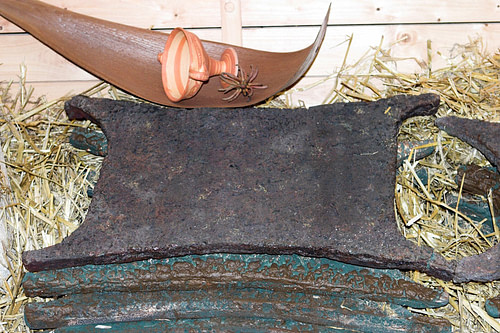
Still, it should be remembered that any certain statements about the ship's ports of call before or after it met disaster based solely on its cargo must be countered with the fact that in the Bronze Age Mediterranean goods from Cyprus, Egypt, Anatolia, and the Levant were widely traded to and fro, including stockpiling and resale at cosmopolitan emporiums such as on Cyprus. However, the fact that much of the Cypriot pottery on board is of different types would suggest that the ship had not sailed directly from Cyprus, where it could have picked up a more homogenous cargo direct from the manufacturing centre, but had just left a port where goods from various sources were stockpiled.
The ultimate destination of the Uluburun ship may well have been mainland Greece if there was indeed two Mycenaeans of an elite status on board, a typical feature of ancient trade where individuals followed a cargo to ensure its arrival as promised or served as messengers from and to the royal household sending the shipment. The cargo was a significant one for the period and would have enriched the recipient and been a significant source of prestige if the Uluburun ship was a diplomatic embassy with gifts from one ruler to another. One can only speculate what were the financial and political consequences of such a valuable shipment not reaching its final destination.
The cause of the shipwreck will probably never be known, but as the wreck lies close to a rocky promontory, it would seem reasonable to suppose that unexpected winds may have driven the ship onto these rocks and so caused it to sink. The presence of weapons on boards reminds that maritime trade was threatened by piracy, but it seems this vessel was dealt its fate by nature's hand. It was a tragedy for the ship's crew and the wealthy merchants who had paid for her cargo, but archaeologists and historians have thus been presented with a fascinating insight into ancient regional interactions. The Uluburun wreck is one of those rarest of occurrences in archaeology of an undisturbed time capsule of the past, providing, in this case, a unique window into Bronze age maritime trade and those who pursued it.
